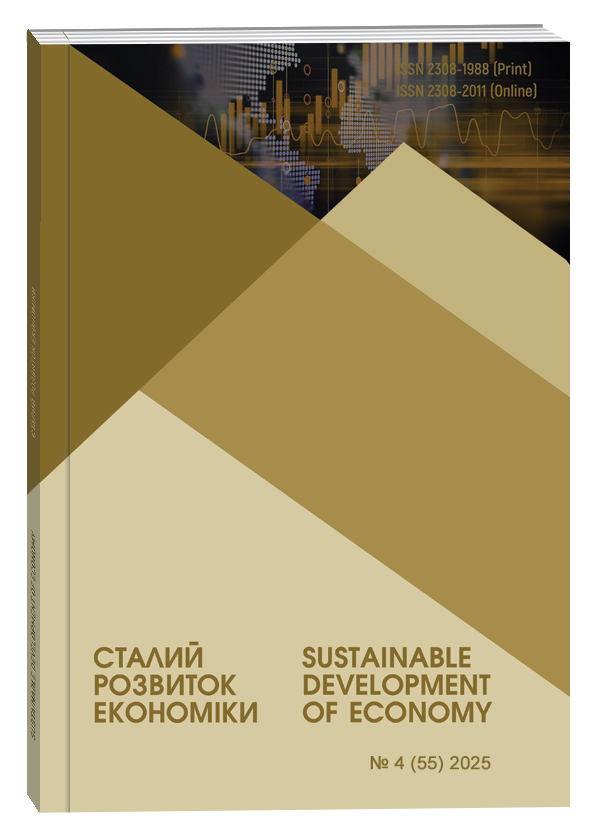TRENDS IN THE DEVELOPMENT OF SUPPLY CHAIN MANAGEMENT SOFTWARE FOR ENTERPRISES
Abstract
The purpose of this article is to analyze the current trends in the development of software solutions for enterprise supply chain management (SCM) in the context of digital transformation. Effective supply chain management is increasingly becoming a strategic priority for enterprises operating under conditions of high uncertainty, global competition, and technological change. The study highlights the growing demand for digital tools that ensure transparency, agility, and efficiency across supply chain processes. The author examines the dynamics of the global and regional SCM software market, characterizes the main classes of software solutions (ERP, APS, TMS, WMS), and identifies key technology providers and platforms. The author’s contribution lies in a systematic analysis of how digital tools influence business performance. Based on recent reports, academic research, and practical cases, the study highlights common challenges: high costs, poor system compatibility, skill shortages, and limited customization. A framework is proposed to evaluate SCM software effectiveness based on enterprise needs and digital maturity. Scientific novelty stems from uncovering new interdependencies between intelligent technologies and SCM transformation. A fresh classification of trends is offered, emphasizing cloud solutions, modular systems, predictive analytics, and full supply chain visibility. The practical significance of the findings lies in the development of actionable recommendations for enterprise managers and IT decision-makers regarding the selection, implementation, and scaling of SCM software. These recommendations are aimed at enhancing the operational and strategic effectiveness of supply chains in both manufacturing and service sectors. The article concludes that adopting digital SCM tools is no longer optional but essential for maintaining competitiveness, especially in volatile economic conditions. However, successful implementation depends on aligning technological solutions with enterprise goals, available resources, and organizational readiness. Further research is recommended to develop ROI assessment models and explore region-specific implementation practices, particularly in emerging markets.
References
Gartner. Forecast Analysis: Supply Chain Management Software, Worldwide. 2024. URL: https://www.gartner.com/en/documents/5394763
Liu J., Yeoh W., Qu Y., Gao L. Blockchain-based Digital Twin for Supply Chain Management: State-of-the-Art Review and Future Research Directions. arXiv preprint. 2022. № 2202.03966. DOI: https://doi.org/10.48550/arXiv.2202.03966
Mullapudi L. B. Optimizing Supply Chain Management with Real-Time Data Integration Platform. International Journal of Computer Sciences and Engineering. 2025. Т. 13, № 5. С. 40–48. DOI: 10.32628/CSEIT25111243
Research and Markets. Growth Trends in the Supply Chain Management (SCM) Software Market, 2024–2029. 2025. URL: https://www.globenewswire.com/news-release/2025/01/07/3005598/0/en/Growth-Trends-in-the-Supply-Chain-Management-SCM-Software-Market-2024-2029-A-Forecasted-43-52-Billion-Landscape.html
Sharma H., Garg R., Sewani H., Kashef R. Towards A Sustainable and Ethical Supply Chain Management: The Potential of IoT Solutions. arXiv preprint. 2023. № 2303.18135. DOI: https://doi.org/10.48550/arXiv.2303.18135
Smerichevska S., Prodanova L., Yakushev O. Digitization of logistics and supply chain management. Smart supply chain management. 2024. Вип. 26. С. 45–52. DOI: https://doi.org/10.46783/smart-scm/2024-26-9
Statista. Global supply chain management software market 2026. 2024. URL: https://www.statista.com/statistics/796252/worldwide-supply-chain-management-software-market
Xu L., Mak S., Brintrup A. Will bots take over the supply chain? Revisiting Agent-based supply chain automation. International Journal of Production Economics. 2021. Т. 241. DOI: https://doi.org/10.48550/arXiv.2109.01703
Gartner. (2024). Forecast analysis: Supply chain management software, worldwide. Available at: https://www.gartner.com/en/documents/5394763
Liu, J., Yeoh, W., Qu, Y., & Gao, L. (2022). Blockchain-based digital twin for supply chain management: State-of-the-art review and future research directions. arXiv preprint, arXiv:2202.03966. DOI: https://doi.org/10.48550/arXiv.2202.03966
Mullapudi, L. B. (2025). Optimizing supply chain management with real-time data integration platform. International Journal of Computer Sciences and Engineering, 13(5), pp. 40–48. DOI: https://doi.org/10.32628/CSEIT25111243
Research and Markets. (2025). Growth trends in the supply chain management (SCM) software market, 2024–2029. Available at: https://www.globenewswire.com/news-release/2025/01/07/3005598/0/en/Growth-Trends-in-the-Supply-Chain-Management-SCM-Software-Market-2024-2029-A-Forecasted-43-52-Billion-Landscape.html
Sharma, H., Garg, R., Sewani, H., & Kashef, R. (2023). Towards a sustainable and ethical supply chain management: The potential of IoT solutions. arXiv preprint, arXiv:2303.18135. DOI: https://doi.org/10.48550/arXiv.2303.18135
Smerichevska, S., Prodanova, L., & Yakushev, O. (2024). Digitization of logistics and supply chain management. Smart Supply Chain Management, no. 26, pp. 45–52. DOI: https://doi.org/10.46783/smart-scm/2024-26-9
Statista. (2024). Global supply chain management software market 2026. Available at: https://www.statista.com/statistics/796252/worldwide-supply-chain-management-software-market
Xu, L., Mak, S., & Brintrup, A. (2021). Will bots take over the supply chain? Revisiting agent-based supply chain automation. International Journal of Production Economics, 241, 108267. DOI: https://doi.org/10.48550/arXiv.2109.01703


